Blogging Marvel’s The Tomb of Dracula, Part Two

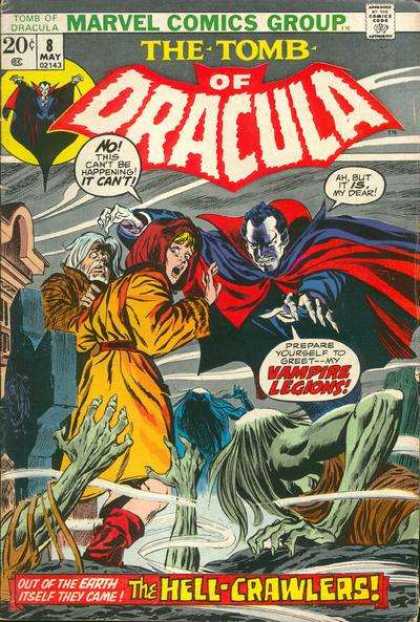 Marv Wolfman took over scripting duties on Marvel’s The Tomb of Dracula with Issue 7. Despite the name, Wolfman was an unlikely choice for a horror title as he had never been much of a horror fan and had limited exposure to the character outside of Stoker’s original novel. Nonetheless, the decision to pair Wolfman with artist Gene Colan and inker Tom Palmer elevated the series to classic status and insured its reputation for decades to come.
Marv Wolfman took over scripting duties on Marvel’s The Tomb of Dracula with Issue 7. Despite the name, Wolfman was an unlikely choice for a horror title as he had never been much of a horror fan and had limited exposure to the character outside of Stoker’s original novel. Nonetheless, the decision to pair Wolfman with artist Gene Colan and inker Tom Palmer elevated the series to classic status and insured its reputation for decades to come.
Issue 7 quickly sets the stage with the introduction of Quincy Harker and his daughter Edith. Quincy is the son of Jonathan and Mina Harker born at the end of Stoker’s novel. Here he is a nearly blind old man confined to a wheelchair with his daughter and faithful dog Saint as his constant companions. He functions as a mentor to Rachel Van Helsing and Taj Nital and has welcomed Frank Drake into the fold. Quincy is an amateur inventor whose vampire hunting gadgets give the story a Bondian edge that works very well. Wolfman’s sense of history and character instantly deepens the story and gives the reader a reason to empathize beyond the immediate sense of good vs. evil.
His innate understanding of people as an amalgamation of family history, mistakes, joys, and tragedies is Wolfman’s greatest strength as an author. Even his Dracula, for all of his cruelty and savagery, is imbued with such humanity and dignity that one can’t help hoping all of them can find peace. Wolfman may be the first writer since Stoker to successfully treat the characters as real people that readers recognize as something other than stereotypes. Finding the key to that empathy is what elevates his take on the property above so many others.
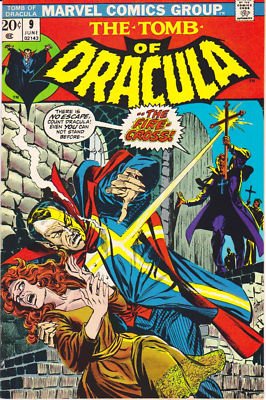
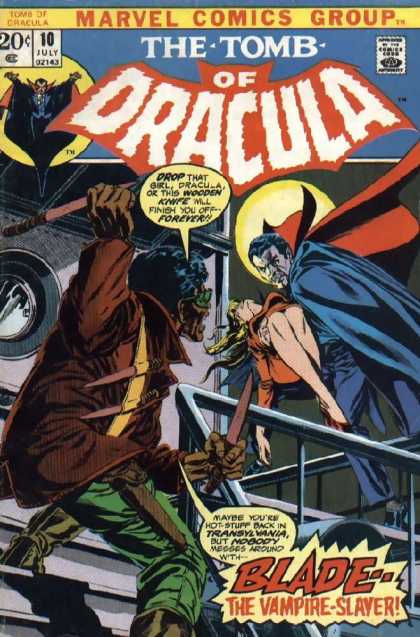 The issue itself builds to a truly terrifying climax with the vampire hunters having a confrontation with Dracula that far exceeds simple cat and mouse games between hunter and prey. Dracula hypnotizes a group of school children earlier in the story and turns them into an attacking army that no adult would want to fight against is a masterstroke of evil and a harbinger of the level of writing to come from the series.
The issue itself builds to a truly terrifying climax with the vampire hunters having a confrontation with Dracula that far exceeds simple cat and mouse games between hunter and prey. Dracula hypnotizes a group of school children earlier in the story and turns them into an attacking army that no adult would want to fight against is a masterstroke of evil and a harbinger of the level of writing to come from the series.
Issue 8 is a breathtaking pulp tale of Dracula seeking out Dr. Heinrich Mortte, who hides his vampirism from his daughter and lives a quiet life as a small town doctor. Mortte successfully performs a blood transfusion on Dracula saving his life after he is poisoned. Dracula becomes aware of Mortte’s resurrection projector which the doctor developed in the hope of extending human life. Dracula intends to utilize the projector to resurrect an army of the undead to help overthrow the human race. The two vampires battle it out with Mortte successfully destroying the projector but at the cost of his own life and revealing his dread secret to his beloved daughter who ends the issue heartbroken next to her father’s corpse.
Issue 9 gets underway with an intriguing opening of a fisherman on the wharf pulling ashore Dracula’s body. We learn in a later flashback that the vampire ran afoul of a motorcycle gang who left him for dead, dumping his body in the river. Dracula becomes embroiled with the local church pastor who first aids and then condemns the vampire and a young teenage couple torn between recognizing established authority or following church teaching in showing charity for the downtrodden. While the issue might be filler, the level of complexity of the scripting and Colan’s always impressive artwork keep it from becoming routine.
Issue 10 is noteworthy for the introduction of Blade the vampire hunter. Years before Wesley Snipes played the role on the big screen; the character was created as a reaction to the blaxploitation movement with Colan drawing Blade to strongly resemble soul singer Bobby Womack. The issue is really a showcase for Blade who turns down an offer to join Quincy Harker’s group to continue working solo as the only vampire hunter able to respond to the threat with the same savagery their quarry offers since he is one of their kind. Surprisingly, Wolfman pits Blade against Dracula right away. Most writers would treat the character’s impressive debut as a filler story and then have him fail miserably when he confronts Dracula at a later date. Instead, we get an immediate confrontation between Blade and Dracula where both hunter and prey nearly perish. Dracula’s willingness to sacrifice an entire passenger ship is the only reason he gains the upper hand. As it is, Wolfman pulls no punches and has Blade barely manage e to save a few people’s lives and his own while Dracula abandons his lackey Clifton Graves to die aboard the exploding ship. Wolfman had little use for the character of Clifton Graves and it seemed he had simply found a chance to discard him. As always, it is never so simple with Wolfman’s scripts. The past always has echoes for his characters.
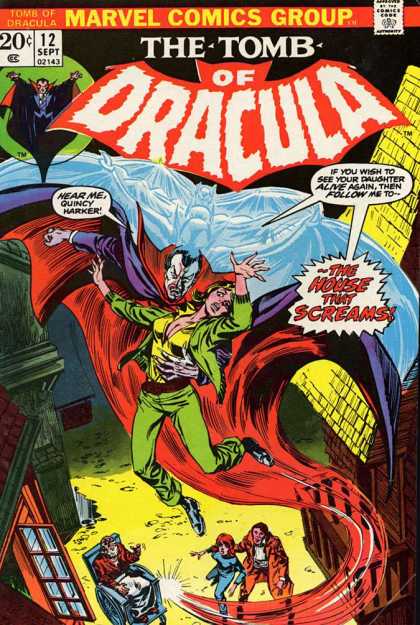
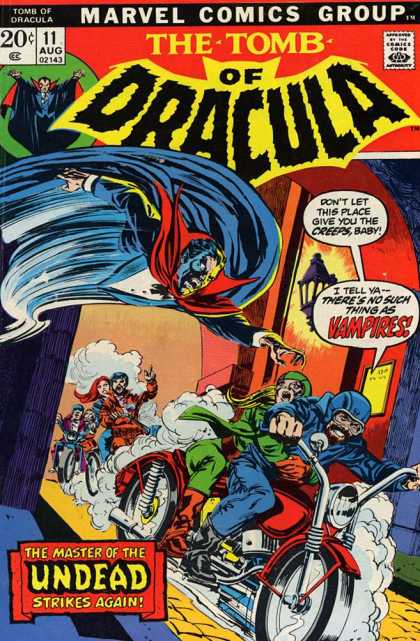 Issue 11 sees Wolfman return to the motorcycle gang that played a role in the flashback two issues before. This ability to weave larger stories out of incidental characters from the past would become a trademark of the series and helped distinguish it from Marvel’s normal fare. Quincy Harker and his companions continue to appear in abbreviated roles in each issue building toward their next fateful encounter with Dracula. The leader of the motorcycle gang, Brand is bitten by Dracula and becomes a vampire. This seems to lead to a traditional shock ending utilized in many vampire short stories with an unlikely character becoming or being revealed as a vampire who escapes destruction/retribution at the story’s conclusion. It is the sort of formula that doesn’t really work for novels, but is quite effective as a sting ending for short fiction. While Wolfman seemingly does the same here with Brand, he rarely discards characters any more than he adheres to conventional storytelling.
Issue 11 sees Wolfman return to the motorcycle gang that played a role in the flashback two issues before. This ability to weave larger stories out of incidental characters from the past would become a trademark of the series and helped distinguish it from Marvel’s normal fare. Quincy Harker and his companions continue to appear in abbreviated roles in each issue building toward their next fateful encounter with Dracula. The leader of the motorcycle gang, Brand is bitten by Dracula and becomes a vampire. This seems to lead to a traditional shock ending utilized in many vampire short stories with an unlikely character becoming or being revealed as a vampire who escapes destruction/retribution at the story’s conclusion. It is the sort of formula that doesn’t really work for novels, but is quite effective as a sting ending for short fiction. While Wolfman seemingly does the same here with Brand, he rarely discards characters any more than he adheres to conventional storytelling.
Issue 12 is where the series builds to its first emotional climax with an issue-long confrontation between Dracula and Quincy Harker’s team of vampire hunters. Edith Harker is taken hostage by Dracula early on in the issue and the reader is conditioned to expect the normal comic book/pulp hokum of the hostage being rescued at the conclusion. Blade enters the fray after an interesting interlude of his domestic life with his exotic dancer girlfriend, Safron. Blade is reluctant to cooperate with Quincy, Rachel, Frank and Taj as he is in a whole other class for the mortal vampire hunters. His second battle with Dracula is even more ferocious than his first. The issue’s climax comes when Edith Harker warns her father away from Dracula’s hideout and the reader sees that Edith is now a vampire. The attack occurred offstage and is all the more horrifying and unexpected because of the suddenness of the revelation. A heartbroken Quincy puts his willing daughter to rest. Edith is eager to be at peace before she claims a human life and forfeits her soul. The issue ends with an enraged and impotent Frank Drake swearing he will end Dracula’s life the next time they meet. The next issue tag promises “The Death of Dracula” for Issue 13 leaving readers eager to learn what will happen next. In the space of just six issues, Marv Wolfman successfully transformed the series into something extraordinary and a title that quickly earned the respect and accolades of their peers in the industry and stands the test of time as a landmark series that is still in print in Essential, Omnibus, or trade paperback Masterworks editions from Marvel.
William Patrick Maynard was authorized to continue Sax Rohmer’s Fu Manchu thrillers beginning with The Terror of Fu Manchu (2009; Black Coat Press). A sequel, The Destiny of Fu Manchu is due for publication in December 2011. Also forthcoming is a collection of short stories featuring an original Edwardian detective, The Occult Case Book of Shankar Hardwicke and an original hardboiled detective novel, Lawhead. To see additional articles by William, visit his blog at SetiSays.blogspot.com
Another good overview of the early TOD. I think it took Wolfman a few issues to really get a handle on the material he was working with, but he was certainly introducing a lot of new ideas and changing things up from the start. I never really felt Quincy Harker’s inventions fit in with the tone of the book, but Quincy himself was a wonderful character, and to an extent I suppose you could read Wolfman’s run on the book as his story as well as Dracula’s.
The fact Wolfman kicked off by bringing in a gang of kids controlled by Drac is interesting, given that he had a memorable issue toward the end of the run which was just the opposite, Dracula facing down a gang of vampires while defending a pair of boys. I think Wolfman’s plotting had some lapses in the details, but his sense of parallel construction was often effective; I do wonder if the contrast of the children-in-peril stories was deliberate.
And I totally agree that what made the book work was Wolfman’s sense of character, and that generally his feel for the family history of the Harkers and Dracula gave it a sense of depth. I’ll go a step further: I think part of what makes Blade work was the fact that he’a a blaxploitation hero who gets thrown into a traditional gothic horror story. Wolfman gets a weird energy, I feel, out of the conflict of genres. Possibly it’s something that could only work in that way at that exact time. (At any rate, he certainly helped Wolfman and Colan get in some Marvel-style fight scenes without breaking the tone of the book.)
At any rate, good piece, and I’m looking forward to more!
All good points, Matthew. Thank you for writing.